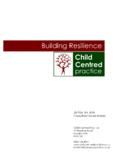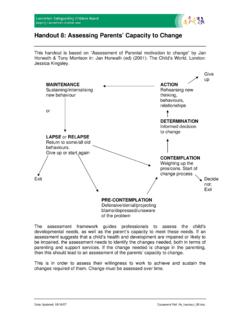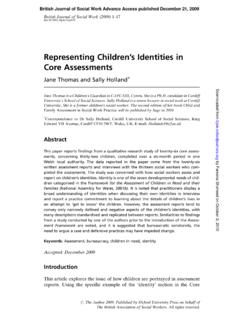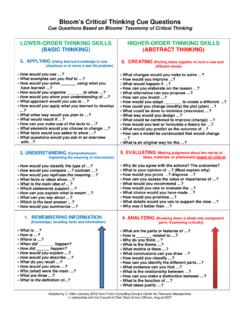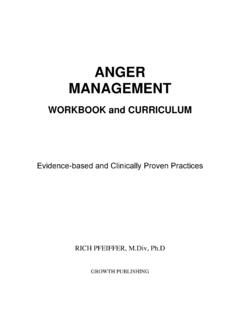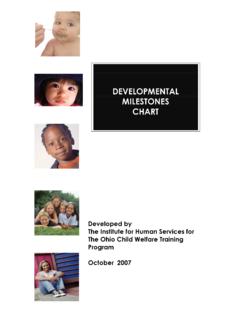Transcription of Reflective Practice - Child Centred Practice
1 Jo Fox BA, BSW Consultant Social Worker Child - Centred Practice 19 Reading Road Pangbourne RG8 7LR 0845 468 4045 Reflective Practice Reflective Practice Child Centred Practice Ltd 2 Contents 1 Reflective Practice .. 3 The Reflective function .. 3 2 What is Reflection? .. 5 Three stages .. 6 3 Model of Structured Reflection .. 7 Cue Questions .. 7 4 Reflection on Practice .. 8 Description of the experience .. 8 What other actions could I have taken? .. 8 How did I feel at the time? .. 8 What I have learnt from this experience? .. 9 Three months later .. 9 5 Reflective Learning Log .. 9 Reflective Practice Child Centred Practice Ltd 3 1 Reflective Practice The Reflective function Fundamental to good partnership working is an ability of the practitioner to have a dialectic or Reflective mindset.
2 This mindset enables practitioners to think critically about the families and children with whom they work. Managers within the organisation contribute to this ability by creating a learning culture that supports the achievement and maintenance of professional competence in this area by: Being critically aware of what we are being asked to do (by our agency and government policy) Being critically aware of the social context within which people live there lives and how lives are constrained or encouraged by that context Being curious and analytical about behaviours and actions of the people to whom we are providing a service Being analytical and ethical about the ways in which we provide services or interventions in order to ensure they are of maximum effectiveness (using ethical measures). 1 Practitioners who use Reflective Practice are much more likely to focus on what they did and how with a view to doing it better next time.
3 They are much more aware of their role in the relationship and how it impacts upon outcomes. Practitioners who are more procedurally driven tend to have prescriptive and restrictive responses to Practice situations and are less inclined to ask why questions. Encouraging curiosity about oneself within the dynamic to support practitioners to understand their own emotional response to the client can be difficult in an organisational climate that is heavily managerial and underpinned by rationalist approaches and target driven philosophies. In other words, managers who spend their time discussing performance indicators, timeliness for the organisation rather than the individual and focusing on procedures over process, will find it difficult to engender an environment which supports Reflective Practice . Forums that can support managers and practitioners to overcome organisational constraints to Reflective Practice include.
4 Co-working Consultation forums Group supervision Allocation case discussions Team meetings External facilitation in casework of high concern Supervision that allows a separation of the managerial and Reflective aspects Mentoring schemes Small teams working on each case supported by lead professional Case file audit tools that promote Reflective Practice Managers should continuously work to promote an ethos of openness, rigour and challenge, as such environments are most likely to support staff who routinely and effectively play their own devil s advocate using opportunities such as supervision surgeries, consultation sessions, co-working and other forums or mechanisms to engage a fresh pair of eyes . 1 Pg 27 RIP, Safeguarding in the 21st Century where to now Barlow and Scott.
5 Reflective Practice Child Centred Practice Ltd 4 Role of Reflective Practice in containment The concept of containment is a significant part of a relationship based approach. It allows us to think about the need to contain the strong arousal experienced by that parent and carers help to contain , the strong arousal experienced by parents and carers before and during our interventions and the actions professionals take to help contain them and the strong feelings experienced by professionals during this process and the actions taken by managers and the organisations to help contain them. This can be referred to as containment of the container 2and requires managers and supervisors who are able to receive the projections of the practitioners and to process them in order to make them more manageable. Bion (1970) identified three types of container-contained relationships: 1.
6 Parasitic an unhealthy and destructive dependence upon the manager or supervisor as a result of the latter being able to receive the workers projections but unable to effectively re-project these into the worker to enable them to develop their internal container. In such circumstances, projections remain with the manager in a passive, holding capacity and create a dependant relationship with the worker. 2. Symbiotic where the worker depends on the manager or supervisor for support, while receiving the manager s re-projections in order to strengthen his internal container and help him/her manage the many very difficult feelings raised by this type of work 3. Commensal relationship a peer supervision relationship with both parties benefiting from mutual containment. Taking time to think about the types of containment relationships you have with the staff you supervise will enable you to support the practitioner more effectively and deliberately.
7 A lot of containment interaction occurs outside formal supervision in venues which are not suitable for good Reflective thinking to occur. Making places and spaces for containment to occur may increase the move from parasitic to symbiotic relationships and thus increase the individuals coping capacity. Reflectivity 2 ( Toasland, 2007) Discussion forum exercise: Use the Gibbs model Reflective sheet provided to think about a containment event that was outside of formal supervision Reflective Practice Child Centred Practice Ltd 5 Reid (1994) Gibbs Reflective Cycle The circular process by which our thoughts affect our actions, which affect the situation we are dealing with and therefore after feedback through the reactions of others involved which can affect how we understand and think about the situation.
8 So we constantly get evidence about how effective or worthwhile our actions are. 2 What is Reflection? (Fish and Twinn 1997) Reflective Practice Child Centred Practice Ltd 6 Three stages The learning opportunity The first sign of a Reflective manager is that they recognise potential errors as places to create learning. Looking for opportunities to learn and improve instead of blame encourages practitioners to own these events with all the potential consequences rather than mask, minimise or justify incidents or actions that could have led to poor outcomes or serious harm for children and their families or others involved such as the practitioner themselves. These opportunities are known as near misses , times when a worse outcome was averted by someone else identifying a critical factor and acting on it in a timely manner.
9 It can sometimes be that the practitioner themselves identifies the mistake and corrects it but it most often occurs in multi-agency forums such as Child protection meetings, or adoption panels, or ad hoc supervision sessions, or through scrutiny or audit processes. The information gathering and critical analysis This is done in a non confrontational environment either as an individual exercise or as part of a group case review. It contains the following key steps: These should be carried out prior to the reflection and should be factual and agreed upon by all members of the reflection. i. A description of the incident ii. The context of the incident iii. Any relevant clarifying statements from others involved The reflection process itself would address the following questions: a) What was I trying to achieve?
10 B) What were the consequences of my action for the practitioner, the Child and family, for my colleagues, for me? c) What do I feel about it? d) What has been the effect on the Child and family, the practitioner and my colleagues? e) What factors/previous knowledge may have influenced me? f) What alternative action could I have taken? The changed perspective This can also be thought of as the learning process, where we see the evidence of understanding through description of feelings and future actions. a) How do I feel now? b) Could I have acted differently? c) What have I learnt? d) How will that influence my future Practice ? e) What has the incident taught me about my values and/or my belief system? f) What ethical principles were involved? 3 3 Spalding (1998).

